In the notes to today’s game between Boris Gelfand and Viswanathan Anand, grandmaster Sergey Shipov gives us some wonderful insights into the psychology of the Soviet man. (Even though Gelfand is from Israel now, he is certainly still under the influence of his Soviet upbringing.) As Shipov says, people who lived in the former USSR are most worried precisely when things appear to be going well. That’s exactly when somebody (or fate itself) will come along and blindside you.
It certainly looks that way for Boris Gelfand in this match. After game 7 he was in great shape, and then he came apart completely in game 8. Now, in game 9, he got a tremendous position out of the opening … and that was precisely when he seemed to start getting worried. Once again he pushed a little bit too hard, and failed to get the most out of his advantage. As Shipov writes, “He sold his gold watch for a ruble.”
I hope you’ll enjoy Shipov’s always entertaining, always insightful commentary, which you can always find in the original Russian at www.crestbook.com. And come back here tomorrow for game 10! — DM
Greetings, dear friends and connoisseurs of chess! How fortunate it is that there are free days in the match for the world championship! They allow the participants in the match to calm down a little bit and recover (which is particularly important right now, after both sides have suffered painful losses), and for us — the spectator and commentators — the days off allow us to take care of our personal affairs without being distracted by bouts of chess fever. I personally had more than enough things to do. But now I am ready for a new round of work…
I suspect that Gelfand today will not repeat his mistakes of the previous game, and will not attempt to throw himself on his opponent like a lion on a mouse. Because he found out that the person sitting across from him is a tiger after all. And that tiger did not die, he only lay down to rest for a moment…
As for the opening, I am no longer certain that we will inevitably see the Meran Variation of the Slav Defense played in the Chebanenko style. Surprises are possible, and they may even be dramatic. I’d still say that Boris is most likely to open 1. d4, but Vishy might veer off to the side at an early stage. So, like Socrates, the only thing I’m certain of is that I’m not certain of anything!
(1) Gelfand,Boris – Anand,Viswanathan [E54]
2012 World Championship Match (Game 9), 23.05.2012
[Shipov, Sergey (translated by Dana Mackenzie)]
1.d4 Nf6
The unexpected, as expected.
2.c4 e6 3.Nc3
A brave decision nowadays! And the most principled one.
3…Bb4
The Nimzo-Indian Defense. An ancient yet evergreen opening. Its theory has tripled over the last 15-20 years.
4.e3
The Rubinstein Variation. White plays solidly and firmly. A more popular choice over the last N years has been Alekhine’s variation, [4.Qc2]
4…0–0 5.Bd3
The knight on g1 retains the option tomove either to e2 or to f3.
5…d5
A capital objection. The continuations [5…c5; 5…b6 give White other possibilities.]
6.Nf3 c5 7.0–0
The tabiya of the Nimzo-Indian Defense. The clash of pawns in the center inevitably leads to a certain amount of simplification, in which both sides have a widechoice of possible pawn structures and piece setups. Mankind has studied this position intensively since the 1930s. Many books have been written about it, but I have to say that the best in the series is Mark Evgenievich Taimanov’s “Nimzo-Indian Defense.” Look for it! That is where you should begin.
7…dxc4 8.Bxc4 cxd4 9.exd4
Anand, after a short think, unloads the center as quickly as possible. This results in a completely typical isolated pawn position. It’s hard to call the pawn at d4 a weakness. White is ahead of Black in development, and he has sufficient motivation for active play in the center and on the kingside. The position of the Black bishop on b4 (instead of on e7) gives him the possibility in the future to carry out an exchange on c3, forming hanging pawns. They might be “hanging,” but they don’t hang… [Shipov is playing with the two meanings of “hang” in chess. He uses two versions of the word “hanging” that differ by one letter; unfortunately this possibility does not exist in English. — DM]
9…b6
The development of the bishop to b7 strengthens his control over d5.
10.Bg5
In the absence of an opposing bishop on e7, God himself has ordained the bishop to pin the knight on f6. For all practical purposes this forces Black to develop the queen knight to d7, not to c6.
10…Bb7 11.Qe2
The first interesting decision. It appears that White intends to put the queen rook on d1. [11.Rc1 has been played most frequently ever since Alekhine. After this there is an ocean of theory, and I will present just one recent example: 11…Nbd7 12.Qe2 (12.Re1 is a move order that is associated first and foremost with the famous game V. Kramnik, G. Kasparov, London 2000: 12…Rc8 13.Qb3 Be7 14.Bxf6 Nxf6 15.Bxe6 fxe6? (15…Rc7!) 16.Qxe6+ Kh8 17.Qxe7 Bxf3 18.gxf3 Qxd4 19.Nb5 with a serious advantage for White.) 12…Re8 13.Rfd1 h6 14.Bh4 Rc8 15.Bb5 Bxc3 16.bxc3 Rc7 17.Ne5 g5 18.Bg3 Rc8 19.h4 a6 20.hxg5 hxg5 21.Bxd7 Nxd7 and after 22.Qh5 White had a very strong attack in V. Ivanchuk – R. Ponomariov, Warsaw 2010.; Also 11.Re1 ; 11.a3 and many other moves have been tried here.]
11…Nbd7
A uniquely useful move, but the next few moves will require more thought…
12.Rac1
Gelfand has been playing the opening more certainly and more rapidly than Anand. In the style of Kramnik he is putting psychological pressure on his opponent… Although there is still a question of who is playing in whose style. Kramnik is a little bit younger than Gelfand, so it’s more likely that he learned from his older colleague. Vladimir and Boris, by the way, have been friends for many years. They have prepared together for major tournaments on numerous occasions. The clock speaks eloquently about who was better prepared for the position that has arisen: 1:50 – 1:37. Vishy is thinking for a long time. He clearly does not remember what needs to be done here and how. Without concrete preparation it is extremely difficult to use only your broad knowledge of the general ideas of an opening to battle against an opponent who is stuffed to the gills with variations. On the other hand, Black’s position has an ample supply of solidity. Black has no obvious weaknesses. The main things to worry about are an increase in tension (for example, with Nf3-e5 and Ra1–d1) or the bishop sortie Bc4-a6.
12…Rc8
The most useful answer. Sometimes for clarity Black will play [12…Bxc3 13.bxc3 after which he can put the queen on c7 and avoid the early … Ra8-c8 altogether. For example, 13…Qc7 14.Bd3 Ng4 15.Be4 (15.h3?? Bxf3 16.Qxf3 Qh2#) 15…Bxe4 16.Qxe4 Ngf6 17.Qe2 h6 18.Bd2 Rac8 19.c4 Qb7 20.Bb4 Rfe8 21.Rfe1 Qa6 22.Ne5 Nxe5 23.dxe5 Nd5 24.Bd6 Ne7 25.c5 Qxe2 26.Rxe2 bxc5 27.Rec2 Nf5 with equal chances for both sides, A. Karpov – L. Psakhis, Benidorm 2002.]
13.Bd3
A highly aggressive setup. White shows that he is interested first and foremost in the Black king, and he will leave the square d5 under Black’s control. The most common move here is [13.Ne5 after which the battle takes place strictly in the center, although sometimes the accent shifts to the queenside: 13…h6 14.Bf4 Nxe5 15.Bxe5 Qe7 16.Ba6 Bxa6 17.Qxa6 Bxc3 18.bxc3 Nd5 19.c4 Nb4 20.Qa3 f6 21.Bg3 and in the game P. Keres – A. Karpov, San Antonio 1972 the players agreed to a somewhat premature draw.]
13…Bxc3
Sooner or later this exchange must take place. Does it seem to you as if Black could postpone it? But excuse me, what move would you propose instead? The simplistic [13…Qe7 has not been seen before. In this case it’s possible for White to play standard maneuvers, but I am attracted to the cheeky idea of transferring the knight on c3 to … c6! Take a look: 14.Nb5! a6 15.Na7! Rxc1 16.Rxc1 Qd6 17.Bxa6 Bxf3 18.Qxf3 Qxd4 19.a3 and Black has problems. On 19…Bd6 White gets an advantage by means of 20.Rd1 Qe5 21.Qg3!]
14.bxc3 Qc7
Now the Black queen has an opportunity to escape the baleful gaze of the bishop on g5. But I am not certain that the order of moves chosen by Anand is optimal. It resembles what would have happened in the aforementioned Karpov-Psakhis game if Black had played the calm … Ra8-c8 instead of the aggressive move Nf6-g4. Which, however, is not necessarily a terribly bad thing.
15.c4
The hanging pawns start to move. This is always dangerous, for both sides. Some of the ideas in the position are illustrated by the game S. Gligoric (yes, that one!) – V. Maksimovich, Belgrad 1999: [15.Rfe1 h6 16.Bd2 (16.Bh4 Nh5) 16…Rfe8 17.c4 Bxf3 18.Qxf3 e5 19.d5 Nc5 20.Bf1 — here Black has blockaded the White pawns and tries to build upon his success — 20…e4 21.Qh3 Nfd7 22.Rc3 Nf8 23.Rg3 Ng6 24.Qg4 Qd7 25.Qxd7 Nxd7 but Black could not equalize after 26.Ra3!]
15…Bxf3?!
I was not able to finish writing the above note before Anand played the idea for Black that I had just showed. But isn’t it a little bit early? I would say that it was at least worth interjecting the moves [15…h6 16.Bd2 (16.Bh4 Nh5) 16…Rfe8 and then thinking some more… is it really worth trading? After all, the bishop on b7 is very powerful, and it’s sad to give it up for a knight.]
16.Qxf3
The surprising pause by the champion speaks for itself. He is obviously not sure if he has done the right thing. One way or another, he has to play … e6-e5. Otherwise, what was the point of exchanging the strong bishop?
16…Rfe8
Astonishing! Black simply accepts the loss of both bishops without any improvement in the pawn structure. By the way, this is a novelty. Gelfand is simply stunned — that’s obvious. He even sat down for a little while with his head in his hands. Just the way I used to in the Moscow State University library, when I was required to review the classics of Marxism-Leninism. However, I simply fell asleep, while Boris, on the other hand, is not in a mood for sleep. He is trying to calm down, gather his wits and play cold-bloodedly. In the game K. Pukkinen – D. Parkinen, Helsinki 2012, after [16…e5 17.Bf5 (threatening Bg5xf6) 17…Rce8 White did not play energetically enough. The move 18.c5! exd4 (18…bxc5 19.dxc5 Nxc5? 20.Qe3+-) 19.c6 Ne5 20.Qf4 would have led to a large advantage — White threatens to take on f6 and on d4. The pawn on c6 is strong, and Black’s king is weak. Apparently Anand analyzed some variations like these and withdrew the hand that the devil was trying to tempt him to place on the e6 pawn.]
17.Rfd1
Simple and strong. White threatens an immediate opening of the center. Go ahead and guess, which pawn will charge into the battle first — c4 or d4? It’s impossible to plan this in advance, everything depends on the opponent’s moves, and on the concrete situation. In summary, White’s advantage is very large, and the challenger’s fans could not have expected such an outcome from the opening even in their dreams. And the champion’s fans didn’t even foresee it in their nightmares… [17.Rfe1 is in no way worse than the text.]
17…h6
Creating luft but also weakening the king’s defenses at the same time.
18.Bh4
This move did not deserve so much agonizing and so many wasted minutes. Boris is nervous in spite of the obvious comfortableness of his position. Maybe even because of that comfort! He was, of course,prepared for a long and heated battle, and all of a sudden his opponent gave him a present… This is the psychology of our Soviet people. When things are at their worst and the tension is so thick you can cut it with a knife, then we are strong and as tough as nails. But when everything is all unbelievably good, when we are showered with money and have plenty to eat and everything else we want, then we start to worry. It’s like the classic song of Boris Grebenshchikov: “Where everything is good, they’ll stab me in the heart. Where everything is crappy, that’s where I feel at home…” His chess-playing namesake has given us a perfect illustration. He proved this thesis by losing his self-control after winning the seventh game and losing the next one with a bang. But now, I hope, he will overcome his nervousness more quickly and without any obvious consequences. In this regard I will remind you of another line from a song by the old group Alpha: “Don’t be afraid of making a mistake, but do it only once. Be afraid of repeating your mistake!”
18…Qd6
Vishy correctly walks in circles. He waits and endures. He’s still a long way from time pressure: 1:12 – 1:01. White needs to prepare a break in the center, and it hardly behooves him to rush. He can create luft for his king, move his d3 bishop… somewhere, and only then launch the pawn storm. [Again, 18…e5 would not work because of 19.Bf5! and it’s not clear where the rook on c8 can hide. Except maybe for 19…Rb8 20.Bg3 Rbd8 — but only a masochist would walk voluntarily into such a pin. And besides that, the blow c4-c5! is coming, which will destroy Black’s defenses.]
19.c5
Another reason for amazement! Who would have thought that such experienced title seekers would so frequently be naughty at the chessboard at the very moments when they should be the most responsible? Maybe everyone expected it but me… I still think that White should have taken the time to strengthen his position a little bit. For example, by playing 19. h3 — it could not possibly hurt to create a window.
19…bxc5
There is no option, otherwise the White pawn would charge on to c6.
20.dxc5
The opening of the file has led to a dramatic activation of the White rooks. Now the threat is to bounce the bishop from d3 to h7.
20…Rxc5
Bravely and strongly played. Anand’s dream would be to pay off his debts with a little material and achieve a clear position with drawing chances. [20…Qe7 21.Bb5! would lead to an extremely difficult position for Black; On 20…Qc7 the strongest is 21.Ba6 Rb8 22.Qg3 Qc6 23.Rd6 preparing a triumphal march for the pawn on c5.]
21.Bh7+
Of course White has to take the queen, in order to justify giving away the pawn.
21…Kxh7 22.Rxd6 Rxc1+ 23.Rd1 Rec8
Black has gotten a rook, a piece and a pawn for the queen. The main danger for him lies in the previously inconspicuous pawn on a2. If White is able to get to the pawn on a7, then he can create a threatening passed pawn, and no matter how many powerful knights Black might place on d5, they won’t be able to hold back the one foot soldier racing down the edge of the board. However, this is really just a fantasy. I have the lasting impression that Gelfand settled for too little. He sold his gold watch for a ruble. Maybe life will dispel my illusions — I would only be glad!
24.h3
Better late than never. [It might have been worth interpolating 24.Qd3+ Kg8 slightly increasing the queen’s scope.]
24…Ne5
Anand has clearly cheered up! His despair has disappeared, and he senses that he has a real chance to save himself. Time is passing but for the moment it is not galloping: 0:46 – 0:54.
25.Qe2 Ng6
An interesting way of playing it. Vishy aims to exchange minor pieces, even at the cost of weakening his pawn structure. [I was analyzing the pugnacious 25…Nd5 26.Kh2 Rxd1 27.Qxd1 Ng6 28.Bg3 and from here Black will attempt to ignore the dark squares. But it remains an open question, who will come to the aid of the pawn on a7?; meanwhile, pawn-grabbing will not work yet for Black: 25…R8c2 26.Qf1 Rxd1 27.Qxd1 Rxa2? 28.Bxf6 gxf6 29.Qb1+ and Black loses a rook.]
26.Bxf6
[26.Bg3 gives White nothing, and in fact it costs him his most valuable pawn: 26…R8c2! 27.Qe1 Rxd1 28.Qxd1 Rxa2 with a guaranteed draw.]
26…gxf6 27.Rxc1 Rxc1+ 28.Kh2
The position has gotten simpler. It appears that Anand intends to hold the seventh rank with his rook, hoping for a fortress. But for the moment I am not certain how strong it is… Let’s say if White places his pawn on a6, his queen on d6, and then plays g2-g3 and h3-h4-h5! Then it might turn out that the Black rook will run out of outposts and the pawn on a7 will collapse.
28…Rc7
And in fact Anand does it. Here it is essential to scrutinize all the nuances and think a long way ahead in terms of schemes and plans.
29.Qb2 Kg7 30.a4
Gelfand stats to execute the plan that I pointed out. The pawn is going to a6. The battle continues!
30…Ne7
Obviously a sensible decision. With a knight on d5 the rook can remain on the seventh rank without the slightest difficulty. However, one must now look at White’s active plans on the kingside. The pieces are starting to align themselves into imaginary configurations in my mind… Let’s say, with the Black knight on d5, the White king materializes on h5 and after Qb2-d2 Black loses the h6 pawn. And, of course, one also needs to look at the White pawn storm. But in that case the assistance of the king is not ruled out. [Indeed, my first worries materialize after the line 30…Rd7 31.Qb8 Re7 32.Qc8 Kh7 33.a5 Kg7 34.a6 Kh7 35.Qd8 (it makes no big difference whether the queen goes to d6 or d8) 35…Kg7 36.g3 Kh7 37.h4! and Black loses, because of 37…h5 38.g4! with the idea of 38…hxg4 39.h5 In view of this possibility, the naive thought arises of playing … h6-h5 and … f6-f5 for Black, but in this case the White queen penetrates to g6 and demolishes the pawn on h6. In sum, life is not as simple for Black as it looks.]
31.a5 Nd5
Black’s pieces form an indestructible construction in the center. White has to ignore them and find targets a little bit to the right…
32.a6
But for starters Boris completes the advance of his wing pawn. So that he can forget about it for the next 20 moves. From here on he will play with the kingside pawns. Here is one more fantasy: f2-f4, g2-g4, h3-h4 and g4-g5. Of course, making sure not to hang anything. It’s only necessary to find the best squares for the king and queen in the process… The clocks read 0:23 – 0:33.
32…Kh7
To stand and wait is the only reasonable strategy for Black in such positions. Of course, Black still believes that his fortress is indestructible. The main question of the moment is: does the advance … f6-f5 favor Black? If so, then White must immediately play g2-g4.
33.Qd4
Played “just in case,” in order to keep Black’s rook from leaving the seventh rank. [It still seems to me that the harshest test is 33.g4 , followed by, for example, 33…Kg7 34.Qd4 Kh7 35.f4 Kg7 36.Kg3 Kh7 37.Kh4!? Kg7 38.f5 Rd7 39.fxe6 fxe6 40.Qd2 with the threat of Kh4-h5. But Black does have the defense 40…Kg6 Still, the position looks extremely troublesome for Black. Extremely!]
33…f5
Understanding the looming dangers, Anand tries to engage the opponent before he gets too close. Now the White pawn can never get to f5.
34.f4
A nontrivial decision. Why? Perhaps Gelfand intends to refute my last thesis and cut a window to Europe by g2-g4!? [“Cut a window to Europe” is a classic phrase from Russian literature. It’s from Alexander Pushkin’s poem “The Bronze Horseman,” about Tsar Peter the Great, who founded St. Petersburg as a way to “cut a window to Europe” for the Russian people, St. Peterburg being closer to Europe than Moscow both in longitude and in attitude. — DM] Then the White pawn has a chance to get to f5, undermining the bastion of the knight on d5. It is again risky to prevent the axe stroke by means of … h6-h5, because of Qd4-f2-g3-g5. [On 34.g4 f4 is worthy of consideration. Then the White king cannot penetrate to h5. But some other ideas have appeared. For example, 35.h4 Kg8 36.Qe5 Kh7 37.h5 Re7 38.g5 hxg5 39.Qxg5 Re8 and Black holds anyway.]
34…Rd7
Not a dangerous ambush. On 35. g4 Black is planning, apparently, to play 35. … Kg6 with the intention of taking on f5 with the king! By the way, speaking of captures… How is White supposed to win if Black takes on f5 with the pawn and places his knight on f6? I don’t see any way yet… If so, then the challenger made a very serious mistake by playing 33. Qd4. It was clearly better to choose 33. g4!
35.Kg3 Kg6
Now Black is completely right to stand and do absolutely nothing. The ball is in White’s court… I admit, for the first time I am seriously convinced that Black will escape with a draw.
36.Qh8
Threatening a check on g8. An easily rebuffed threat.
36…Nf6 37.Qb8
The players have picked up the pace slightly. The clock is forcing them to: 0:03 – 0:10.
37…h5
Wha-a-at? Why? Why does Vishy leave the square g5 naked, when White’s queen can get there? Strange… It seems to me that all he had to do was shuffle with his pieces in place.
38.Kh4
The king frees up a route for the queen. It appears that Black will have to watch over the g3 square by playing … Nf6-e4. But it’s still not clear what he is going to do when the White queen announces its presence on f3. Possibly Black will get some chance for counterplay against the dangerously placed White king.
38…Kh6
We stand, we wait, we endure. Now let’s keep a close eye on the opponent’s clock — maybe he’ll let his flag fall!
39.Qb2
Approaching g3 by a roundabout route.
39…Kg6 40.Qc3
Threatening Qc3-g3-g5.
40…Ne4
The time control has passed. [Interestingly, the first time in the match that has happened! — DM] The dust has settled! It has become clear that with White’s king on h4 Black is willing and eager to lose the h5 pawn, because in that case he actually wins with the maneuver … Rd7-d8-h8! So the champion has everything under control. He simply chose this method to achieve a peaceful result. One of the advantages of this method is the fact that it has become even harder for White to carry out the break g2-g4… The draw is very close now. Boris is suffering at the board. Vishy is calm, radiant and pure, just like Buddha.
41.Qc8
[Let me show the trap in its full glory: 41.Qf3 Nf6 42.Qg3+ Kh7 43.Qg5 (43.Kg5 Ne4+) 43…Ne4 44.Qxh5+ Kg7 45.g4 (45.Qe2 Rd8) 45…Rd8 46.gxf5 Rh8 White loses his queen and suffers a catastrophe.]
41…Nf6
The attempts to penetrate from the side fail. So, perhaps it’s time for White to move his king away from h4? But then he will have to reckon with the bind … h5-h4 followed by a transfer of the knight to g3. Another winning attempt would be to play the sharp break g2-g4 at the necessary moment… But I still can’t find an effective way to do this in my analysis. In every line Black has sufficient resources.
42.Qb8
When the opponent can’t do anything, there is no need to rush. First you should try to lull him to sleep, sing him a lullaby, or in some way confuse the co-author of your future positional masterpiece. Then you turn to your main plan. If there is one…
42…Re7
But isn’t this an inaccuracy? Now White has the idea of blowing up the position with g2-g4 followed by Qb8-e5-g5+ and then the rook at e7 will just happen to be under attack… No, that’s hardly likely to work. In the proposed variation Black saves himself by the retreat … Nf6-g8, after which the rook will be defended by the knight. [42…Kh6 was completely safe.]
43.g4
As predicted. Gelfand tries his last practical chance.
43…hxg4 44.hxg4 fxg4
[Of course not 44…Nxg4?? 45.Qg8+ Kh6 46.Qg5+ Kh7 47.Qxe7 1–0.]
45.Qe5
Threatening a fatal check on g5.
45…Ng8!
Anand foresaw everything. He is quick and exact. [45…Nd5? fails to 46.Qg5+ Kh7 47.f5; 45…Nh7? runs into 46.f5+ Kh6 47.f6 Rd7 48.Qh5#]
46.Qg5+
[Or 46.Qh5+ Kg7 47.Qxg4+ Kf8 with a comfortable position for Black.]
46…Kh7 47.Qxg4 f6
Ugly but practical.
48.Qg2
Boris persists in his efforts to win. I think he’s sorry to give up on a game where he had such a large and clear advantage.
48…Kh8
Here Black does not face even any microscopic problems. Even losing the pawn on e6 would not change aything.
49.Qe4 Kg7
Here Anand proposed a draw. Strictly speaking, its not his business… In such positions it is up to the person with the advantage to decide whether to propose a draw or continue to fight. On the other hand, Vishy is right in the sense that the position has now become completely boring. Boris thought, thought and AGREED TO A DRAW.
This game was a huge missed opportunity for Gelfand. He had serious chances to win after his opponent’s unsuccessful play in the opening. But he got a little bit overeager, grabbed his material a little bit too quickly, and then did not make the most of his chances in a superior endgame. Anand was lucky today… but it was a world champion’s luck! The score in the match remains even: 4.5 – 4.5. Only three more games with the classical time control remain.
And with that, I will say goodbye. Thank you for your attention, friends. This has been grandmaster Sergey Shipov. We await further developments. Until tomorrow!
½–½
Download PGN here.
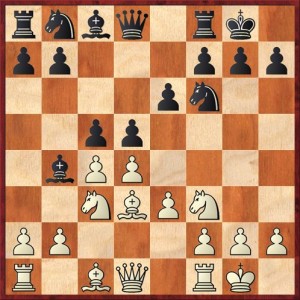
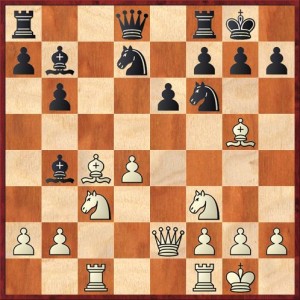
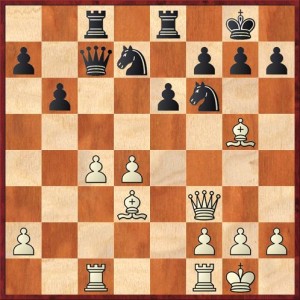
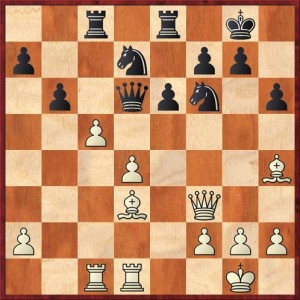
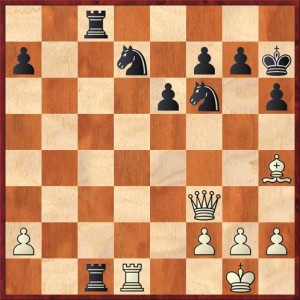
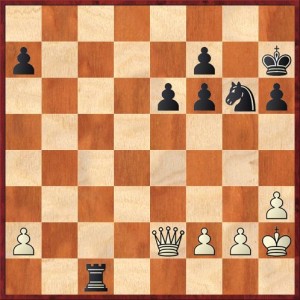
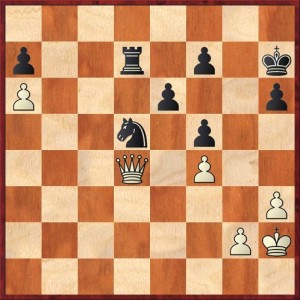
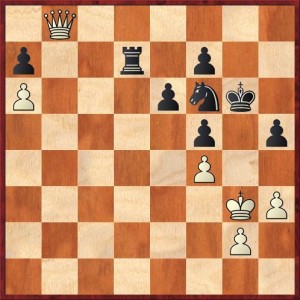
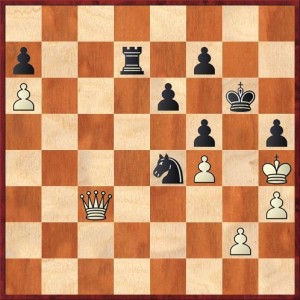
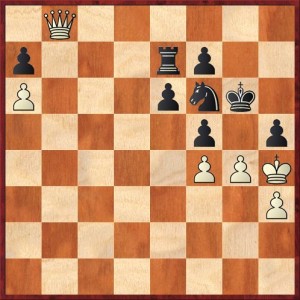
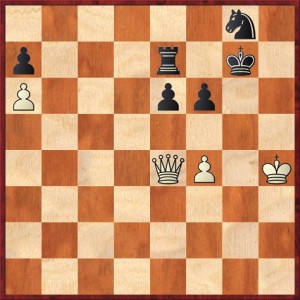



{ 4 comments… read them below or add one }
I’ve corrected a few typos, caused by my haste to post this translation in timely fashion. However, the typos remain in the PGN. Nothing substantive except on move 34, where I mentioned a pawn going to f6 (should have been f5).
In the youtube/cbv file Shipov gives a longer line with 33 g4. I’m very interested in how his evaluation at the end of the line translates (also see chessvibes.com). If you have a spare moment…?
left my comment to the 9th game beneath the 100k-article. Sorry for that.
Thanks so much to Sergey Shipov for commenting and to Dana Mackenzie for sharing this pearl with those, who do not master Shipovs native tongue.